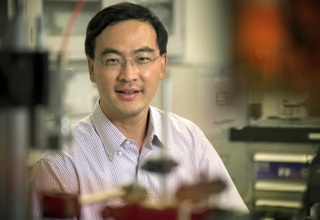Apr 25 2015
A University of Texas at Arlington electrical engineering researcher will use a National Science Foundation grant to discover as-yet-unknown materials that will provide better imaging, compute faster or make communications more secure.
 Weidong Zhou, UT Arlington professor of electrical engineering
Weidong Zhou, UT Arlington professor of electrical engineering
Weidong Zhou, UT Arlington professor of electrical engineering Weidong Zhou, an electrical engineering professor who specializes in nanophotonics, has been awarded a $120,000 National Science Foundation grant to develop manmade nanostructured photonic materials to accomplish those stated goals and eventually help in the nano-manufacturing process.
Zhou’s collaborator on the project is Xiuling Li, an associate professor of electrical and computer engineering, at the University of Illinois Urbana-Champaign.
The team’s work will help to enhance the emerging U.S. nano-manufacturing industry for the production of 3-dimensional electronics, 3-dimentional optical metamaterials, tissue engineering and energy conversion and storage.
“Of course, we have to obey the laws of physics in the research but if we can bend the light or manipulate the light in ways not possible in natural materials to create some of these new uses, that’s the objective of the research,” Zhou said. “What Professor Li and I are trying to do is to explore a unique scalable nano-manufacturing process for the manufacturing of three-dimensional functional metamaterials. Such an approach will overcome current roadblocks toward integrated photonics based on functional metamaterials and completely enable new ways of controlling light.”
Zhou used the famous invisibility cloak from the Harry Potter movies as an example.
“If we can use existing light to see something different, that’s what we’re after,” Zhou said.
One challenge the team faces, Zhou said, is how to develop a process for the fabrication of functional metamaterials, which can be integrated on a chip. He said how the team makes three-dimensional metamaterials that can be placed on a chip at the right optical frequency is a key to the material development.
Khosrow Behbehani, dean of the UT Arlington College of Engineering, said Zhou’s work in this sector is on the cutting edge.
“These new materials could revolutionize computing, communication, sensing and imaging. This collaborative project will advance U.S. nanomanufacturing and prepare our future workforce in the areas of nanophotonics and nanomanufacturing,” Behbehani said.